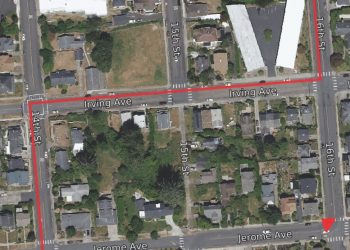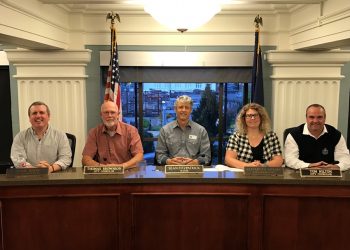BOZEMAN, Mont. – Healthcare workers in Montana are getting vaccinated for COVID-19. Montana Public Radio’s Nick Mott has more on what the vaccination process will look like as the rollout ramps up.
At the Gallatin County Fairgrounds, a big white sign just next to a wooden statue of a waving grizzly bear reads, “Vaccination Center.”
“This is Gallatin County’s first Point of Dispensing, or POD as it’s commonly referred to.”
That’s Patrick Lonergan, Emergency Management Chief for Gallatin County. Local health departments have been practicing POD systems for years during flu season. As more COVID-19 vaccine becomes available, more of these PODs will pop up across the county and the state. But the setup will be more or less the same. Some counties are experimenting with other methods, like drive-thrus.
Today, Brian Nickolay, assistant chief of the Hyalite fire department, is getting his vaccine. At times, he’s involved in transporting COVID patients in ambulances. His experience is representative of the about 800 to 1,000 other people getting vaccinated here this week.
“I don’t feel nervous at all about gettin’ it.”
He says he doesn’t expect it to be any different than a flu shot. Like the other recipients here, he signed up for a time slot online. Now that the time has come for his shot, he hands in a nine-question form and waiver at the front desk.
Inside, there are eight long tables, each with a healthcare professional in a mask giving shots. Nickolay takes a seat, and the worker at his table starts to prepare.
She’s swabbing his arm. She’s taking the lid off the needle. And, she just poked him right in the arm. And she’s pushing the dropper. It’s done! She’s disposing of the needle, and it looks like putting a band-aid on him.
“You get the Tasmanian Devil today!” she says.
He gets a Tasmanian Devil.
Now, Nickolay heads to another room, just behind the main facility. Rene Fredette is a volunteer today, and a registered nurse at Bozeman Health.
“Once the individual gets their vaccine, they come in here and they’re observed for either 15 minutes or 30, depending on their own history.”
That’s to make sure there are no negative reactions to the vaccine. Just over a dozen people are seated in widely spaced folding chairs, scrolling through their phones. Nickolay joins them.
Sitting in his chair, Nickolay says the vaccine was no big deal.
“I mean, it’s a needle, you can feel it, But it’s no worse than any other shot, giving blood, anything like that.”
When his 15 minutes are up, Nickolay gets up to leave and schedule his next shot, 28 days later. This is the Moderna vaccine, and that time period will look slightly different for other brands, like Pfizer.
The whole thing’s over in less than half an hour. He signed up online with the CDC, and they’ll check in with him virtually on how he’s feeling. When he’s out in public, he’ll still wear a mask.
Registered Nurse Rene Fredette has been seeing health care workers like Nickolay coming and going all week.
“Some of them have been direct providers or office staff, and they know what it’s been like — the burden of the virus and the PPE and the fears people have — so they are delighted to be here.”
Montanans over 70 and with certain underlying health conditions are next in line for the vaccine, but the timeline is contingent upon how many doses the state receives week to week.












